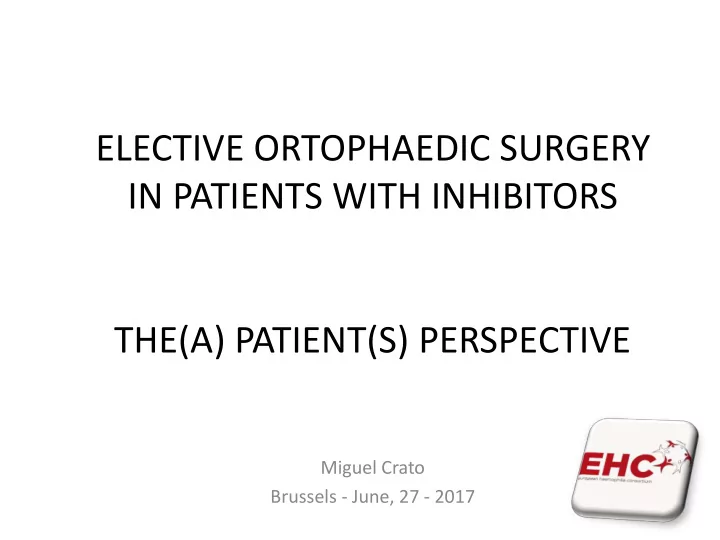

ELECTIVE ORTOPHAEDIC SURGERY IN PATIENTS WITH INHIBITORS THE(A) PATIENT(S) PERSPECTIVE Miguel Crato Brussels - June, 27 - 2017
PATIENT BACKGROUND PATIENT BACKGROUND • Long life inhibitors(since 12 years old, bypassing agents only since 20 years old) • Long history of target joint bleeding(right knee) • Pain and mobility severely affected • Other joints affected (domino effect) • Quality of life decreasing through the years
PRE SURGERY KNEE STATUS • Range of motion Ext: 25° Flex. 75° • No bleeds in the last 3 years • No previous synovectomy of the knee • On prophylaxis 2 x week(before physio) • Frequent knee inflammation • Severe pain • Half an hour to start walking in the morning
TIME FOR A DECISION • Years of talks with hematologist and orthopedist • The inhibitor factor – life threatening surgery! • Higher risk vs better quality of life(rate of success) • First time for a knee replacement surgery (KRS) in Portugal to a patient with inhibitors (pwi) • Is there a real reason to wait, in pwi? • Joint decision for KRS taken one year before
PREPARING THE KRS • Multidisciplinary team meetings (hematologist/orthopedist/physiatrist/chief nurse) • Dental care near optimum (to minimize the risk of infection) • Water physio one year before KRS (Muscular strengthening) • Be mentally prepared (support of family, friends, work, day to day tasks) • Be prepared to have a very slow recovery after KRS
CHOOSING THE BYPASING AGENT Patient history • Previous surgery in 2007 with rFVII (Cholecystectomy) • Previous synovectomy of the elbow with rFVII • Adapted prophylaxys 2 x week with APCC (just before water physio) • Joint bleedings treated with APCC • Other bleedings(major cuts, dental extractions) treated with rFVII
TESTING Decision with the hematologist to do a thrombin generation test(TGT) and ROTEM – Thromboelastometry • TGT – very similar results • RT – Better results with rFVII (faster clot formation and clot more consistent) • Conclusion : Shared decision to choose rFVII for the KRS and for the first two weeks, and APCC after that
THE SURGERY ( 20 March 2017) • Technically equal, with extra control for hemostasis (regardless the option for rFVII, APCC was available) • 2 hours and a half duration • Implant of Triathlon PS(striker) • No transfusion needed
TREATMENT PLAN POST SURGERY • 48 hours in intensive care - 8mg – Immediate pre surgery (just for precaution) 7 mg - 2/2 hours for 32 hours • Good hemosthasis 7 m - 3/3 hours for 57 hours • Hemoglobin dropped to 11g/dl after surgery (no transfusion needed) 7 mg - 4/4 hours for 44 hours • Low levels of pain 7 mg - 6/6 hours for 66 hours rFVII 7 mg -8/8 hours for 24 hours 7 mg 1 x per dia - day 10 to day 14 post surgery TRANEXAMIC ACID 1g – for surgery, intra-articular 500mg - 6/6h, first week , 8/8h until day 10 • Hospital discharge on day 15
KNEE RECOVERING EVOLUTION DAY 3 Day 15 DAY 75
PHYSIOTHERAPY • Started 48 hours after surgery • Range of motion: ext: -5° flex 40° HOSPITAL • On foot at day 3(marvellous sensation) • First steps with a walker on day 4, crutches on day 6 • Stairs on day 12 • rFVII infusion pre physio on hospital • Hospital discharge: ext: -5° flex 75°
PHYSIOTHERAPY AFTER HOSPITAL • Physio 3 x day/week on gym (with APCC) General objectives • Recover joint amplitudes • Promove knee cap mobility • Soft tissues functionality • Gain of flexibility, strength and motor control • New joint vs dynamic body posture Adaptation for a pwi • Shared objectives between pwi and physio therapist • Reduce stress • Avoid bleeding and inflammation • • Use of ice and periods of rest Recuperation slighty delayed due to painfull arthropaty • in both ankles and a tendinitis in the left shoulder Longer sessions • Teaching for home therapy and • autonomy Range of motion now – ext 0° flex 90 °
“ You look so taller ” – My wife after first standing up straight “ I´m so happy with the results, everything went so well “ – My orthopedist who performed the surgery “ The hemosthasis control was perfect and the knee looks so good ” – My hematologist “ I do not remember the last time I slept without a cushion under my knee ” – me 20 May 2017 - APH Parents Conference- two months after KRS
THANK YOU FOR YOUR ATTENTION
Recommend
More recommend